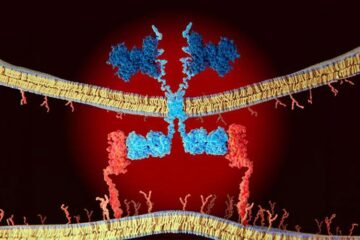The dark matter of the brain

Electrical synapses connect neurons in almost all brains; however, little is known about them. A study now shows for the first time where these specific synapses occur in the fruit fly brain and that they influence the function and stability of nerve cells.
Credit: MPI for Biological Intelligence, i.f. / Julia Kuhl
Electrical synapses – omnipresent and yet hardly explored.
They are part of the brain of almost every animal species, yet they remain usually invisible even under the electron microscope. “Electrical synapses are like the dark matter of the brain,” says Alexander Borst, director at the MPI for Biological Intelligence, in foundation (i.f). Now a team from his department has taken a closer look at this rarely explored brain component: In the brain of the fruit fly Drosophila, they were able to show that electrical synapses occur in almost all brain areas and can influence the function and stability of individual nerve cells.
Neurons communicate via synapses, small contact points at which chemical messengers transmit a stimulus from one cell to the next. We may remember this from biology class. However, that is not the whole story. In addition to the commonly known chemical synapses, there is a second, little-known type of synapse: the electrical synapse. “Electrical synapses are much rarer and are hard to detect with current methods. That’s why they have hardly been researched so far,” explains Georg Ammer, who has long been fascinated by these hidden cell connections. “In most animal brains, we therefore don’t know even basic things, such as where exactly electrical synapses occur or how they influence brain activity.”
An electrical synapse connects two neurons directly, allowing the electrical current that neurons use to communicate, to flow from one cell to the next without a detour. Except in echinoderms, this particular type of synapse occurs in the brain of every animal species studied so far. “Electrical synapses must therefore have important functions: we just do not know which ones!” says Georg Ammer.
Distribution in the brain
To track down these functions, Ammer and his two colleagues, Renée Vieira and Sandra Fendl, labelled an important protein building block of electrical synapses. In the brain of fruit flies, they were thus able to show that electrical synapses do not occur in all nerve cells, but in almost all areas of the brain. By selectively switching off the electrical synapses in the area of visual processing, the researchers could show that the affected neurons’ reaction to certain stimuli is much weaker. Furthermore, without electrical synapses, some nerve cell types became unstable and began to oscillate spontaneously.
“The results suggest that electrical synapses are important for diverse brain functions and can play very different functional roles, depending on the type of neuron,” Ammer summarizes. “These synapses should therefore also be integrated in connectome studies.” The connectome is a map of all neurons and their connections in a brain or brain area. Often, this information is reconstructed from electron microscope images – where electrical synapses are largely invisible. How these can be integrated into connectome investigations and what other secrets electrical synapses hold, is subject for further studies.
Journal: Current Biology
DOI: 10.1016/j.cub.2022.03.040
Article Title: Anatomical distribution and functional roles of electrical synapses in Drosophila
Article Publication Date: 5-Apr-2022
Media Contact
All latest news from the category: Life Sciences and Chemistry
Articles and reports from the Life Sciences and chemistry area deal with applied and basic research into modern biology, chemistry and human medicine.
Valuable information can be found on a range of life sciences fields including bacteriology, biochemistry, bionics, bioinformatics, biophysics, biotechnology, genetics, geobotany, human biology, marine biology, microbiology, molecular biology, cellular biology, zoology, bioinorganic chemistry, microchemistry and environmental chemistry.
Newest articles

Economies take off with new airports
A global study by an SUTD researcher in collaboration with scientists from Japan explores the economic benefits of airport investment in emerging economies using nighttime satellite imagery. Be it for…

CAR T–cell immunotherapy targets
Pan-cancer analysis uncovers a new class of promising CAR T–cell immunotherapy targets. Scientists at St. Jude Children’s Research Hospital found 156 potential CAR targets across the brain and solid tumors,…

Stony coral tissue loss disease
… is shifting the ecological balance of Caribbean reefs. The outbreak of a deadly disease called stony coral tissue loss disease is destroying susceptible species of coral in the Caribbean…





















